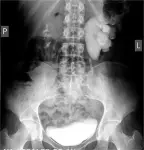Diverticula of the ureter are acquired from false diverticula resulting from herniation of epithelium through the muscular layer of the ureter and characterized by the presence of multiple outpouchings smaller than 5 mm. It is sometimes bilateral and is often located in the upper two-thirds of the ureter.
What is the Pathology of Diverticula of the Ureter?
The pathology of Diverticula of the ureter is:
-Etiology: The cause of diverticula of the ureter is not clear, but chronic inflammation and/or obstruction are likely causes.
-Genes involved: Gene involvement is not clear.
-Pathogenesis: The sequence of events that lead to diverticula of the ureter includes urothelial hyperplasia caused by chronic inflammation and the consequent impaction of the hyperplastic urothelium into the subepithelial connective tissue.
-Morphology: The morphology associated with diverticula of the ureter shows multiple bilateral small outpouchings of the ureter involving the proximal two-thirds of the ureter
-Histology: The histology associated with diverticula of the ureter shows focal hyperplasia of the urothelium protruding into the muscle.
How does Diverticula of the Ureter Present?
Patients with diverticula of the ureter typically affect men 60-70 years of age, but it is a very uncommon occurrence. Most patients are asymptomatic, but it may be seen in patients with a history of chronic urinary tract infection or haematuria.
How is Diverticula of the Ureter Diagnosed?
Diverticula of the ureter are diagnosed by intravenous urography, antegrade urography, or retrograde pyelography.
How is Diverticula of the Ureter Treated?
There is no specific treatment indicated in asymptomatic patients.
What is the Prognosis of Diverticula of the Ureter?
The prognosis of diverticula of the ureter is generally good but can worsen in association with urothelial carcinoma.



